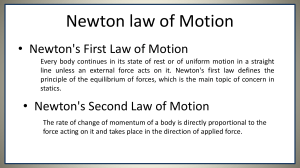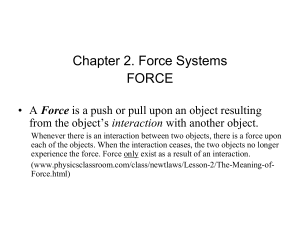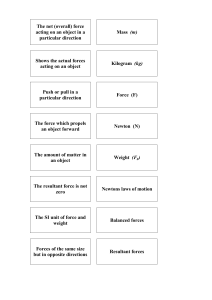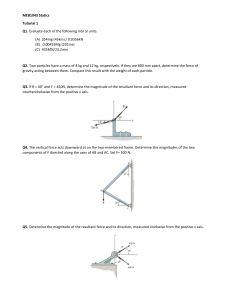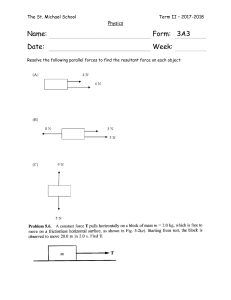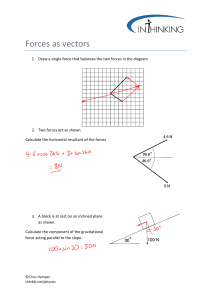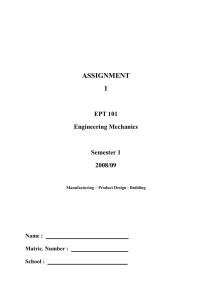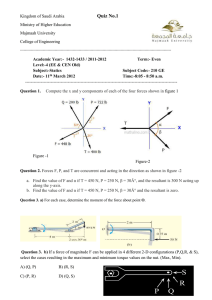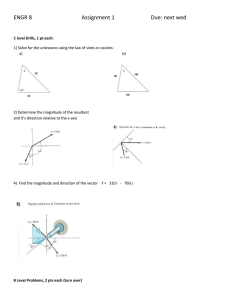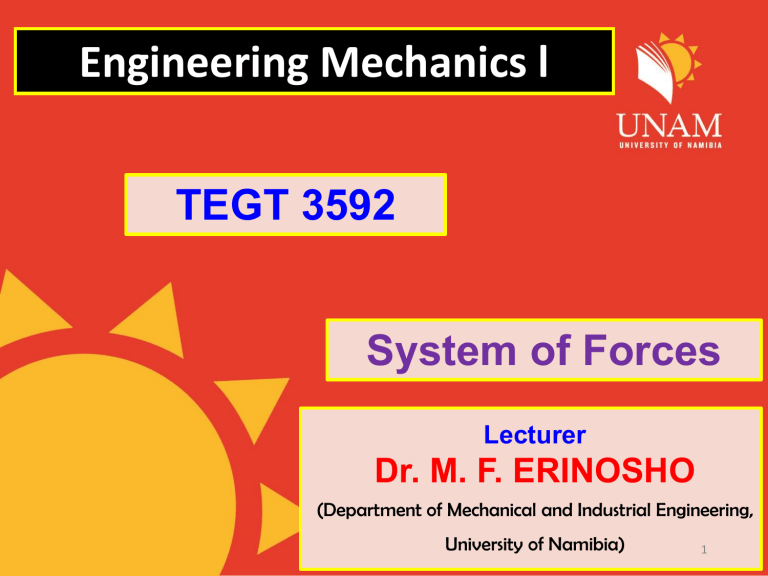
Engineering Mechanics l TEGT 3592 System of Forces Lecturer Dr. M. F. ERINOSHO (Department of Mechanical and Industrial Engineering, University of Namibia) 1 Course Outlines Mechanics Engineering mechanics System of Forces Classification of force system Coplanar Forces Non-Coplanar Forces Classification of Coplanar forces Concurrent Forces Law of Parallelogram of Forces Law of Polygon of Forces 2 Mechanics This is defined as that branch of science, which describes and predicts the conditions of rest or motion of bodies under the action of forces. Engineering mechanics This applies the principle of mechanics to design, taking into account the effects of forces. 3 SYSTEM OF FORCES Do you still understand the Newton's First Law of Motion. It has helped us to define a force as an external agency which tends to change the state of rest or of uniform motion of a body. In simple words, the action of one body on any other body can be called a Force. 4 These actions may be of various forms : pull or push on a body, gravitational force, force exerted by an elastic spring etc. 5 In order to specify a force, you need to know its magnitude, direction and the point of application. Its magnitude is expressed as Newton in SI unit. Graphically, a force is represented by drawing a line to scale, showing its magnitude and an arrowhead indicating its direction. A combination of several forces acting on a body is called a System of forces or a force system. 6 Classification of force system The system of forces can be classified according to the arrangement of the lines of action of the forces of the system. The force system may be classified as (i) Coplanar or non-coplanar, (ii) Concurrent or non-concurrent, and (iii) Parallel or non-parallel. 7 Coplanar Forces Forces acting in the same plane are called coplanar forces. Consider the Figure below, forces ā and ƀ are acting in vertical plane ABCD. They are called coplanar forces. Forces c and d are also 8 called coplanar forces as they are acting in one plane. Non-Coplanar Forces If the line of action of various forces do not lie in the same plane then the forces are called noncoplanar forces. 9 Classification of Coplanar forces Coplanar forces can also be classified as parallel forces and non-parallel forces. If the line of action of forces are parallel and point in the same direction they are called parallel forces, If they point in opposite directions, they are called unlike parallel forces, 10 In (a), the forces P, Q and S are parallel forces. (a) (b) 11 Concurrent Forces If all the forces acting on a body meet at a point, they are called concurrent forces. Forces a, b and c as shown in the Figure below are concurrent forces as they are meeting at point 0 12 whereas forces d , e and f are called as nonconcurrent forces because all the three forces are not meeting at a point. 13 Law of Parallelogram of Forces If a system of coplanar forces is acting on a body, its total effect is usually expressed in terms of its resultant. If the two coplanar forces meet at a point as shown below, their resultant may be found by the law of parallelogram of forces. 14 The law of parallelogram of forces states that, “If two forces acting at a point are such that they can be represented in magnitude and direction by the two adjacent sides of parallelogram, the diagonal of the parallelogram passing through their point of intersection gives the resultant in magnitude and direction”. 15 • Consider two forces P and Q acting at a point O in the body as shown. Their combined effect can be found out by constructing a parallelogram using vector P and vector Q. • The diagonal passing through O represents their resultant in magnitude and direction. • The magnitude R of the resultant and the angle it makes with P are given by : 16 Where, α is the angle between P and Q θ is the angle between R and P β is the angle between R and Q . 17 The above two forces can also be combined by using the law of triangle of forces which states that if the second force is drawn from the end of the first force then the line joining the starting point of first force to the end of the second force represents their resultant. 18 From the triangle of forces, by using trigonometric relations, you can find that, 19 Example 1 Determine the magnitude and direction of the resultant of the forces shown. 20 21 Use trigonometry to calculate the magnitude and direction of the resultant. 22 Example 2 Determine the magnitude F and the angle , if the resultant of the two forces acting on the block is to be a horizontal 80-N force directed to the right. 23 Draw the parts of parallelogram that are known: Analyze the triangle forming the lower half of the parallelogram. 24 25 Law of Polygon of Forces If more than two forces are acting on a body, then their resultant can be found by repeated applications of the parallelogram law or the triangle law for one pair of forces at a time. You may start with any two forces and find their resultant first and then add vectorially to this resultant the remaining forces taking one at a time. In the final form, a polygon would be completed. 26 Example Consider five forces each of 80 N acting at 0 in a body, Draw forces of polygon and show the resultant of the forces. 27 Let us construct a polygon such that the forces A, B, C, D and E represent the sides of a polygon taken in order, each force being drawn from the end of earlier force then their resultant is represented by the line joining the starting point of the first force A to the end of the last force E. 28 Thank you 29
